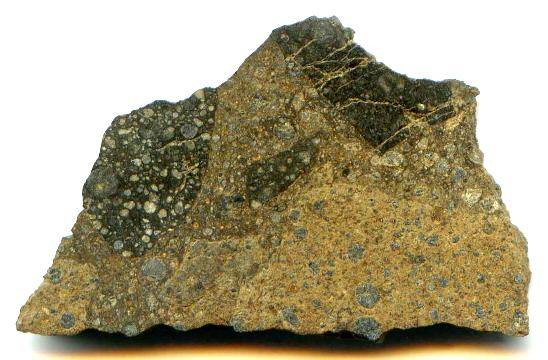NWA R-Type (Unclassified)
R chondriteChondrites are the most common meteorites accounting for ~84% of falls. Chondrites are comprised mostly of Fe- and Mg-bearing silicate minerals (found in both chondrules and fine grained matrix), reduced Fe/Ni metal (found in various states like large blebs, small grains and/or even chondrule rims), and various refractory inclusions (such Click on Term to Read More brecciaWork in Progress ... A rock that is a mechanical mixture of different minerals and/or rock fragments (clasts). A breccia may also be distinguished by the origin of its clasts: (monomict breccia: monogenetic or monolithologic, and polymict breccia: polygenetic or polylithologic). The proportions of these fragments within the unbrecciated material Click on Term to Read More, rumurutiiteMember of a rare group of chondrites, formerly named the Carlisle Lakes group, after a meteorite found in Australia in 1977. It is now named for the type specimen Rumuruti that fell in Kenya, Africa, in 1934. Rumuruti is the only witnessed fall of this group and only one small (tentative classification)
(possibly paired with NWA 4814) 
click on photo for a magnified view Found before 2007
no coordinates recorded Many possibly paired stones and fragments representing a unique rumurutiite are thought to be distributed in both Europe (300 g stone) and the United States (400 g fragments). The specimen shown above is reportedly from a lot of two large, fresh, partially fusion-crusted stones weighing together 2,635 g, acquired by American collectors/dealers. A type sample from one or more of these stones was sent to Northern Arizona University for analysis, assignment of a provisional NWA-series number, and classification; however, the exact provenance for the specimen shown above has been lost. As photographed, the specimen above exhibiting pronounced dark and lighter lithologies bears a strong resemblance to both the 300 g R3–6 NWA 2943 found in 2005, and to the 1,120 g R4 [R3–6] chondrite NWA 4814 found in 2006, either of which might or might not share a common source meteoriteWork in progress. A solid natural object reaching a planet’s surface from interplanetary space. Solid portion of a meteoroid that survives its fall to Earth, or some other body. Meteorites are classified as stony meteorites, iron meteorites, and stony-iron meteorites. These groups are further divided according to their mineralogy and Click on Term to Read More. A search for more information on these meteorites could help determine whether they derive from a common meteorite, or perhaps are launch paired.
| 3 | 4 | 5 | 6 | |
|---|---|---|---|---|
| Homogeneity of olivineGroup of silicate minerals, (Mg,Fe)2SiO4, with the compositional endpoints of forsterite (Mg2SiO4) and fayalite (Fe2SiO4). Olivine is commonly found in all chondrites within both the matrix and chondrules, achondrites including most primitive achondrites and some evolved achondrites, in pallasites as large yellow-green crystals (brown when terrestrialized), in the silicate portion Click on Term to Read More |
>5% mean deviation | homogenous | homogenous | homogenous |
| Pyroxene | predominantly low-Ca pyroxene |
low-Ca and Ca-rich pyroxene |
only Ca-rich pyroxene |
only Ca-rich pyroxene |
| Feldspar | small glassy intergrowths |
isolated intergrowths | networks forming | well-developed networks |
| Sulfides | even distribution | even distribution | even distribution | mobilized |






